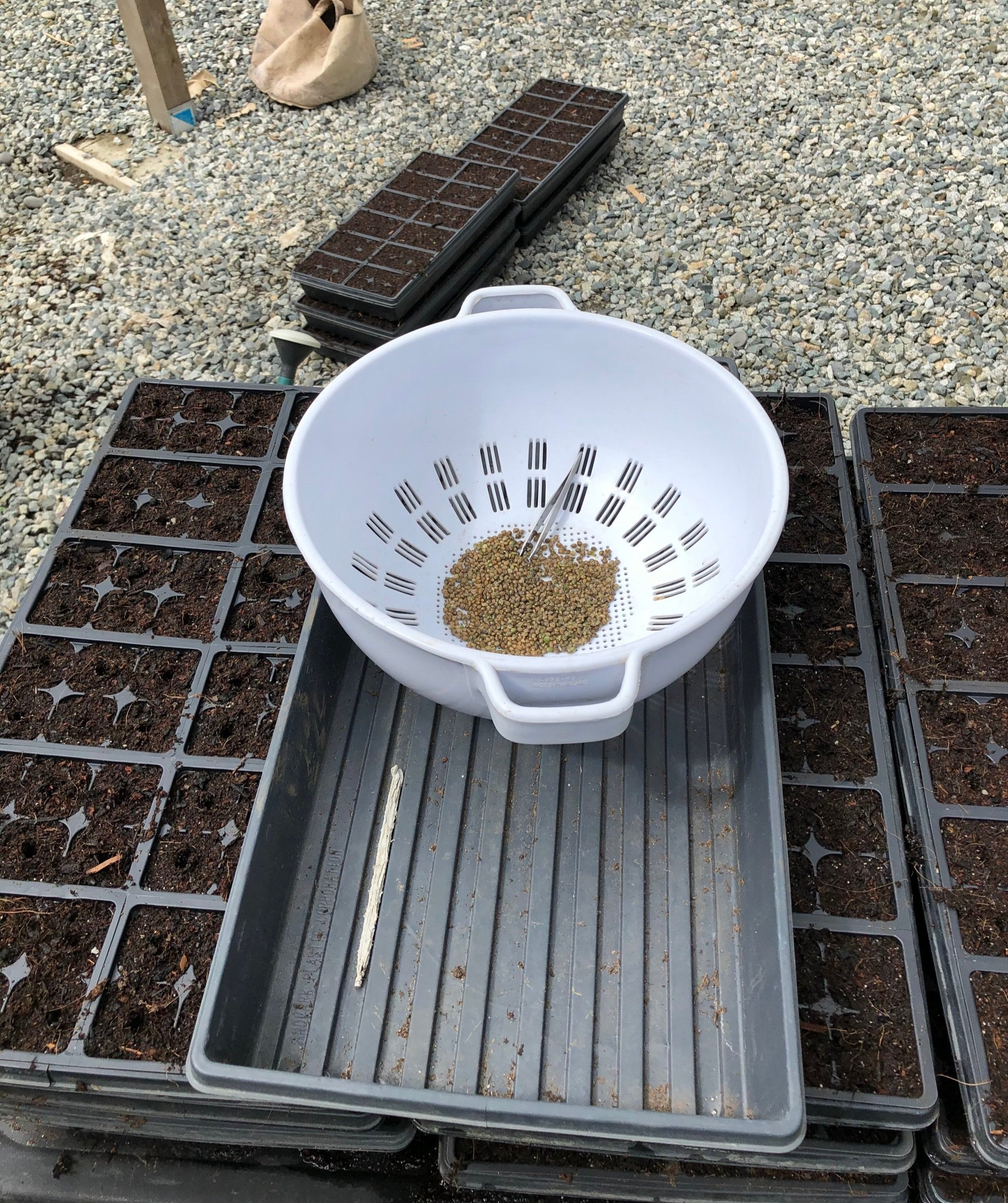A Better way to Germinate Cannabis Seeds
Don’t germinate your Cannabis seeds in a wet napkin just because the internet told you to.
Commercial growers don’t use wet napkins for seed germination.
We have developed a better way to germinate cannabis seeds using Hydrogen Peroxide scarification. This protocol can improve germination ratios and helps to protect your seeds from being killed by mold.
Best of all, this process is simple, and you probably already have everything you will need to start cannabis from seed.
I have germinated tens of thousands of seeds using this technique, but you don’t have to take my word for it. Here is a science paper detailing the benefits of this approach.
Article Contents:
Buying Cannabis Seeds
Feminized Seeds
Cannabis Seed Storage
Germinating Cannabis Seeds
Soaking Seeds
Starting Seeds in Soil
Planting Cannabis Seeds
Germination Climate
Download the Grow Guide
Seed Germination FAQ
Buying Cannabis Seeds
The starting point of a successful weed garden is a viable seed.
The genetics of the strain that you choose will have a big impact on the quality and quantity of cannabis that you harvest. Not all strains are suitable for all growing conditions. Seeds should be sourced from a reputable breeder who can provide information about the growth habit of the seeds they produce.
Fortunately, this is easier than it ever has been with many breeders and seed banks available to mail seeds anywhere in the world.
Unfortunately, convenience comes with a price, with seeds of some strains costing up to $20 each. When handling valuable seeds, capable of producing copious amounts of quality cannabis, we obviously want to achieve as high of a germination percentage as possible.
Feminized Seeds
As you probably know, cannabis is dioecious, which means that there are both male and female cannabis plants.
Female plants are desirable for production of fragrant flowers, and males are usually culled to avoid seeding females.
Feminized seed have been bred to produce only female plants, where regular seeds usually produce about 50% male and 50% female plants.
It can take 6-8 weeks of growth before it is possible to visually identify male from female plants.
If you are only growing a few plants at a time, you want to be sure that they are all female from the very beginning by purchasing feminized seeds.
Cannabis Seed Storage
Cool, Dry, and Dark- When seeds are stored correctly, they will remain viable for many years. Seeds are best stored in tinted jars, containing desiccant packs, in the fridge.
When you take your seeds out of the fridge, let them come to room temperature before opening so that you don’t get condensation in the jar.
The germination percentage of cannabis seeds benefits from this cold stratification, which simulates winter conditions, and helps to break seed dormancy. Most reputable breeders will cold stratify their seeds after harvest, so that they are ready to sprout when you receive them.
Seeds can be quickly destroyed by high temperatures, so never leave them in a hot car or greenhouse.
Seed Germination Supplies
You will need these supplies to germinate your cannabis seeds:
Planting media of your choice
Nursery flat or similar tray
Potable Water
Household Hydrogen Peroxide (3%)
A kitchen colander
One chopstick
Tweezers
Following these steps will ensure that your seeds germinate to fulfill their dank potential:
Germinating Cannabis Seeds
Don’t be afraid to scarify. Cannabis seeds have a durable seed coat that needs to be softened for the seed to emerge. A great way to achieve this is to Chemically Scarify the seeds by soaking them in an acidic solution:
H202 Solution for Seed Scarification:
Combine: 1 TBSP (15ml) of 3% Hydrogen Peroxide solution (typical household H2O2) With 1/3 of a cup (80ml) of Potable Water. That’s it.
Soaking Seeds
Soak seeds in a labeled glass containing the scarification solution. If you are growing multiple strains, don’t mix them up.
Seeds should soak for 18-20 hours prior to planting. In addition to softening the seed coat, this treatment will kill fungal pathogens and drive oxygen into the seed.
Strain the seeds from the solution, and rinse generously with Potable Water. A kitchen colander works great for this job.
Warm temperatures and penetration of water and oxygen into the seed will signal to the embryo that conditions are favorable for germination.
You will probably see root tips starting to emerge from the seeds after they have been soaked. You don’t want to damage these root radicles, so handle with care.
Starting Seeds in Soil
Cannabis seeds can be planted into many different soil mediums.
The seeds have been scarified, so this is a perfect time to introduce some beneficial microorganisms or bioprotectants to boost their defense against fungal disease.
I like to plant seeds in small cups or plug trays filled with organic potting soil. This provides natural probiotics to help protect the emerging plant from pathogens. The planting media should be moist, and loose before placing the seed.
Peat pucks are widely available and work well for starting seeds. Adding a bit of liquid seaweed, or some other biostimulant, to the water when hydrating pucks can promote seed establishment. Squeeze excess water from hydrated pucks before placing seed.
Pre-moistened planting plugs are convenient propagation medium. These spongy plugs usually come in trays of 50 and are ready to sow seeds into right away.
Planting Cannabis Seeds
When your planting media of choice is prepared, create a small hole or “dibble” about ¼”- ½” deep in the soil surface.
A chopstick is the perfect tool for this job.
Place each seed in a hole and cover with loose soil. The best tool for sowing small amounts of seed is a pair of tweezers.
Once a tray of seeds is seated, you can use your chopstick to tamp media around each seed to ensure full contact with the soil.
Germination Climate
Once the seeds are all seated, they can be watered in gently to avoid disruption, and placed in an area that is between 70-80f with adequate light.
A windowsill may work, but if you can provide supplemental broad-spectrum lighting, even better.
It is a good idea to label your seedlings as you seat them in their propagation plugs. Different color plant tags can be used to identify different strains.
Relative Humidity between 50% and 70% is ideal, but don’t worry if it’s a bit drier. Do not cover or dome the seeds but do water the media when it dries out. Seedlings are vulnerable to fungal pathogens, so airflow is important.
Shoots should emerge within 3-5 days, although some strains may take a little longer. Once the shoots have begun to emerge, increase the light intensity so that they do not become leggy.
The seed husk will often remain on the shoot as it unfurls. This husk will usually be pushed off by the expanding cotyledons (seed leaves) but can be carefully removed with tweezers. As soon as these leaves emerge, your new plant will start to photosynthesize, and enter the seedling stage.
Download the Grow Guide
Seed Germination FAQ
-
No, it is not necessary to soak seeds, but your germination ratios will improve if you scarify your seeds.
-
If you soak your seeds for more than about 20 hours, the roots radicles can get long enough to be damaged when you plant your cannabis seeds.
-
Yes, there are many ways to germinate seeds. Roots are more likely to be damaged when they are allowed to elongate from the seeds prior to planting.
-
Yes, an organic potting soil is the perfect medium for germinating cannabis seeds.
-
Yes, soil should be evenly moist, but not soaking wet prior to planting cannabis seeds.
-
In addition to sunlight, a broad spectrum light will help your seedlings get a healthy start.
-
The perfect temperature for seed germination is from 70 to 80f (20-26 Celsius)
-
Between 50 and 70 percent relative humidity is perfect for seed germination.
-
Cannabis seedlings will usually break the soil surface from 2-4 days after they are planted.
Old seeds can be slower to germinate.
-
The seed coat can sometimes resist being pushed off by the expanding seed leaves. In this case it is best to spray the seed coat with water to soften it, then carefully remove the seed coat with tweezers.
-
Seeds should be planted between 1/2” and 1/4” below the soil surface.






